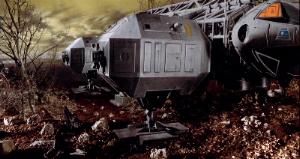Another Time, Another Place
| Belgium (Flemish) |
Splitsing |
|
2 Feb 1977 |
| France/Canada |
Autre temps, autre lieu |
Another Time, Another Place |
2 Apr 1977 |
| Germany |
Fast weider daheim |
Almost Back Again |
12 Feb 1978 |
| Italy |
Un altro tempo, un altro luogo |
Another Time, Another Place |
7 Mar 1976 |
| Japan |
When the Moon Splits into Two
|
24 Jul 1977 |
| Netherlands |
Tijd en Plaats onbekend |
Time And Place Unknown |
4 Aug 1978 |
| Poland |
W innym miejscu, w innym czasie |
|
1 Apr 1977 |
| Portugal |
Outro Tempo, Outro Local |
Another Time, Another Place |
5 Mar 1977 |
| Spain |
Otro tiempo, otro lugar |
Another Time, Another Place | 30 Dec 1976 |
| South Africa | Ander Tyd, Ander Plek |
Other Time, Other Place | 20 Jan 1978 |
| Sweden |
|
|
10 Jul 1976 |
| USA (New York) |
|
|
8 Feb 1976 |
| USA (San Francisco) |
|
|
21 Feb 1976 |
| UK (ATV) |
|
|
18 Dec 1975 |
| UK (LWT) |
|
|
6 Mar 1976 |
An eerie phenomenon grips the moon. Moonbase Alpha Personnel become duplicated and come face to face with their future selves on Earth again. But for how long? ITC summary
- Shooting script 20th March 1974. Blue page amendments 25th March, 1st April.
- Martin Landau made notations in his script copy including "I feel Koenig makes a lot of decisions for no reason - no building of drama..." and "Koenig is a shmuck in this script!"
- According to Sylvia Anderson, Judy Geeson wanted to walk off the set, possibly after conflict with the director over her performance, or over her character.
- Shooting schedule dated 1 April 1974. Filmed 2 April to 19 April 1974, plus (B unit, filming at the same time as Missing Link) 22nd, 23rd and 25th April; total 15 days
- Edited into the 1976 Italian compilation movie Spazio 1999
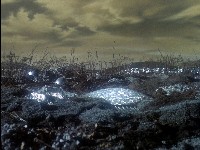
Large domes (greenhouses?) are seen in the This Episode segment of the titles; these are not in the episode.
- The space warp effects are relatively simple but effective: flashing coloured filters, slow motion and double exposures. Note also the split screens: during the pan from the dead Koenig past Helena to the door opening for the live Koenig; also the two Helenas (Zienia Merton stood in for the opposite Helena during this scene).
Unused special effects from the episode. More SFX footage
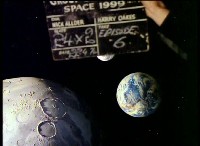
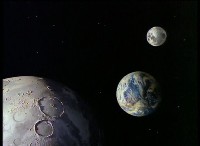
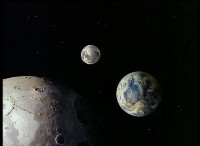
- Original score by Barry Gray, recorded at Wembley on Tuesday 25th June 1974.
- ITC Music Cue Sheet
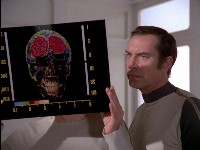
It would be hard enough to fit two brains in one skull, let alone wire them both in. This over-literal detail was added over writer Johnny Byrne's objections. The thermographic scans seem to show just two hemispheres of a normal brain.
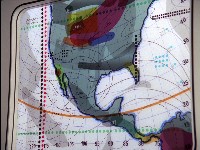
- It would seem that the minimum "emergency" round-trip time from Moon to Earth is less than 48 hours before lunar impact, including less than ten hours of surface exploration... The required velocity would then be 8 kilometres per second to enter a low Earth orbit, followed by approx. 7km/s to move to a 130km lunar parking orbit in only 24 hours plus another 2km/s braking manoeuvre to land on the Moon. Including losses, course corrections etc., the total velocity requirement would be (2 x 20km/s = ~40km/s). This is presumably the Eagle's maximum speed.
- The Moon's motion through space seems highly variable. It re-enters orbit around Earth only six days after encountering the mysterious cosmic phenomenon in interstellar space. It seems the relative positions of the two Moons does not change at first (Carter and Koenig presumably have to travel twice as far as the Earth-Moon round-trip outlined above, i.e. round-trip time of 3-4 days). Bergman only discovers the Moons are on collision course after Koenig and Carter have returned. The collision velocity seems very high as the second Moon moves one lunar diameter every six seconds, i.e. 500-600 kilometres per second (in contrast, the lunar escape velocity is only 1.5 kilometres per second!!). Perhaps time passes more quickly than usual due to the mysterious unknown force?
- The Moons return to the exact same orbit as before (we presume the mysterious unknown force is at work), but one is obviously in a retrograde orbit (orbiting in the opposite direction, so they will collide). A normal orbit takes a month; if the Moon entered orbit when the other Moon is on the opposite side of the Earth it should take 7 days for them to collide (both travelling a quarter of the lunar orbit). In the episode it takes 48 hours.
- The radioactive deserts suggest a nuclear war or nuclear power accident; the cause is not explained.
- The geodesic domes were based on the ideas of Richard Buckminster Fuller (1895-1983), a US architect, inventor and philosopher who devised in the 1960s a spherical structure of light but strong triangular units. The structure needed no internal supports and the hemispherical shape promoted air circulation, while the low surface area diminished heat loss.
- The episode states there are nine planets. According to Dragon's Domain a tenth planet was discovered in 1996. The script actually states there are 11 planets. In 2006 a new classification was agreed, in which the solar system has just 8 planets, excluding Pluto (now classified as a dwarf planet like Charon, Ceres, and Eris). It would take some time to find all planets in a solar system by observation.
- The choice of Santa Maria in California as a location that survives the devastation was inspired by a real-life study. The Santa Maria valley is known for vineyards and nearby Vandenberg Air Force Base, which tests ballistic missiles and launches satellites.
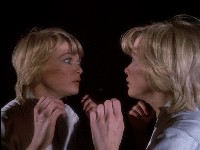
1 fatality, Regina Kesslann.
The "Earth" Alphans suffered several fatalities: John Koenig, Alan Carter, Regina Kesslann, Helena Russell.
Alpha Technology:
Unnumbered Eagles travel to the second Moon and Earth
Earth (a future or alternative future?). This is the Earth, but not the world we knew. It's an Earth where perhaps we never existed. Or perhaps we have yet to be born.
Aliens:
None
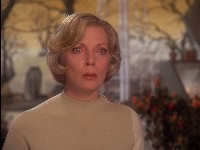
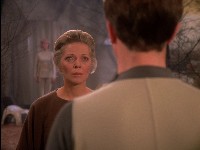
The background is mismatched in this sequence. In long shot, Helena (or her double) is immediately in front of the door. In close up, she is some distance in front of it. Also, the double's hair style is much "bigger" than Barbara Bain's (thanks to James C.).
Also note: Alpha's gravity towers (as seen in Black Sun) are seen on Earth. Why? Perhaps they function as radiation shields.
- A very eerie episode, especially in the scenes of the deserted Moonbase and Regina's frightening nightmare. Judy Geeson gives a stunning performance, fragile, confused, desperate (the script does not specify the sudden changes of emotion and is much less dramatic). Her long time boyfriend, theatre designer Sean Kenny, had recently died (in 1973) of a brain tumour.
- One of the first episodes to focus on Alan. Also makes Koenig and Helena's relationship much more overt (their doppelgangers on the planet are married). Both Paul and Bergman get nice roles as well.
- The Alphans also return to Earth in Journey To Where. The picture of Earth here is consistent with a future version of the Earth of 2120 (the remark about "a civilization once flourished here" could refer to the metrocomplexes). The script specifies the top of a tower protruding from the ashy soil- Koenig recognises it as the Santa Maria satellite tower which used to be hundreds of feet high.
- "A story with strong, human interest and special appeal to the female audience. Direction good, with telling use made of special effects. However, the general pace is marred by the lethargic performance of Barry Morse." 4/5 Critical Commentary by Johnny Byrne (1975)
External Links
![]() Year 1 - Episode 6
Year 1 - Episode 6 ![]()

